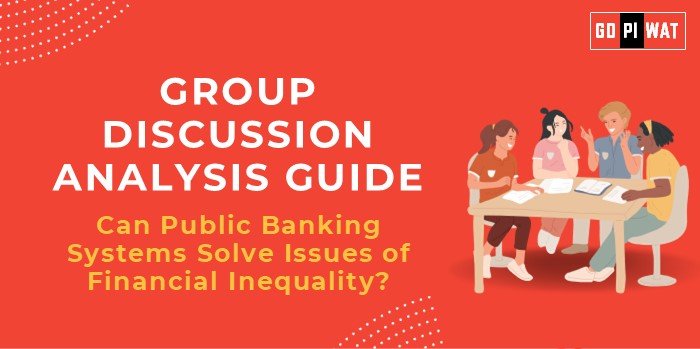📋 Group Discussion (GD) Analysis Guide: Can Public Banking Systems Solve Issues of Financial Inequality?
🌐 Introduction to the Topic
- Opening Context: Financial inequality remains one of the most significant challenges of our era, with over 1.4 billion adults worldwide still unbanked as of 2021. Public banking systems have become a focal point in addressing this gap, providing financial access to underserved populations globally.
- Topic Background: Public banks, which prioritize inclusivity over profit, hold a significant share of global banking assets. Institutions such as the Industrial and Commercial Bank of China demonstrate the potential of state-owned banks in bridging financial disparities.
📊 Quick Facts & Key Statistics
• 🌍 Global Unbanked Population: 1.4 billion adults worldwide lacked access to formal financial services in 2021.
• 🏦 Public Banks’ Asset Share: State-owned banks, including the Industrial and Commercial Bank of China, dominate global banking in many regions.
• 🇮🇳 India’s Financial Inclusion Progress: The Financial Inclusion Index improved from 43.4 in 2017 to 60.1 in 2023, signifying expanded access to formal banking services.
• 💰 Wealth Gap Indicator: The richest 10% of the global population earn 52% of total income, compared to just 8.5% for the poorest half.
• 🏦 Public Banks’ Asset Share: State-owned banks, including the Industrial and Commercial Bank of China, dominate global banking in many regions.
• 🇮🇳 India’s Financial Inclusion Progress: The Financial Inclusion Index improved from 43.4 in 2017 to 60.1 in 2023, signifying expanded access to formal banking services.
• 💰 Wealth Gap Indicator: The richest 10% of the global population earn 52% of total income, compared to just 8.5% for the poorest half.
👥 Stakeholders and Their Roles
- Government: Enacts policies to ensure the equitable functioning of public banks, regulates financial inclusion initiatives, and monitors wealth disparity.
- Public Banks: Offer affordable credit, financial literacy programs, and targeted services for marginalized groups.
- Private Sector: Collaborates in areas like digital infrastructure, technology, and microfinance initiatives.
- Global Organizations: Institutions like the World Bank promote financial inclusion globally through funding and technical assistance.
🏆 Achievements and Challenges
- Achievements:
- 📈 Enhanced Financial Inclusion: India’s Financial Inclusion Index growth reflects successful public-sector banking policies like Jan Dhan Yojana.
- 💸 Affordable Credit Accessibility: Public banks provide low-interest loans to farmers, small businesses, and underserved communities.
- 🌍 Global Benchmarks: Public banks in Germany and China have demonstrated how state-driven models can reduce inequality.
- Challenges:
- ⚠️ Efficiency and Corruption: Public banks often face criticism for inefficiency and political interference in lending practices.
- 🌐 Digital Divide: Rural and marginalized communities face barriers to accessing banking services due to technological and literacy gaps.
- 💻 Resource Constraints: Public banks often struggle with balancing financial sustainability and inclusivity.
🗣️ Effective Discussion Approaches
- Opening Approaches:
- 📊 Statistical Approach: “Over 1.4 billion people remain unbanked globally, which demonstrates the critical need for inclusive public banking systems.”
- ⚖️ Contrast Approach: “While public banks control a significant share of global banking assets, wealth inequality persists, with the richest 10% earning 52% of global income.”
- Counter-Argument Handling:
- 🔍 Recognize public banks’ inefficiencies but propose solutions like technology-driven transparency and performance benchmarks.
🔍 Strategic Analysis of Strengths & Weaknesses
- 🏅 Strengths: State-driven focus on inclusivity, proven success in boosting financial access in emerging markets.
- ⚠️ Weaknesses: Political interference, limited innovation compared to private-sector banks.
- 🌱 Opportunities: Digital financial inclusion programs, collaborations with fintech companies to improve outreach.
- ⚡ Threats: Rising competition from private banks, cybersecurity risks in digital banking systems.
📋 Structured Arguments for Discussion
- Supporting Stance: “Public banks are key to reducing financial inequality by offering affordable credit and inclusive banking services.”
- Opposing Stance: “Inefficiencies and political interference often prevent public banks from achieving their potential.”
- Balanced Perspective: “While public banks are instrumental in addressing inequality, partnerships with private-sector entities and regulatory improvements are essential.”
🎓 Connecting with B-School Applications
- Real-World Applications: Students can explore case studies in financial inclusion or assess public-private collaborations in banking.
- Sample Interview Questions:
- 💡 “How can public banks reduce global wealth inequality?”
- 💡 “What role does technology play in the success of public banking systems?”
- Insights for Students: Public banking initiatives often align with topics like economic development, sustainable finance, and social impact.


